2015 NISSAN LEAF lock
[x] Cancel search: lockPage 341 of 412
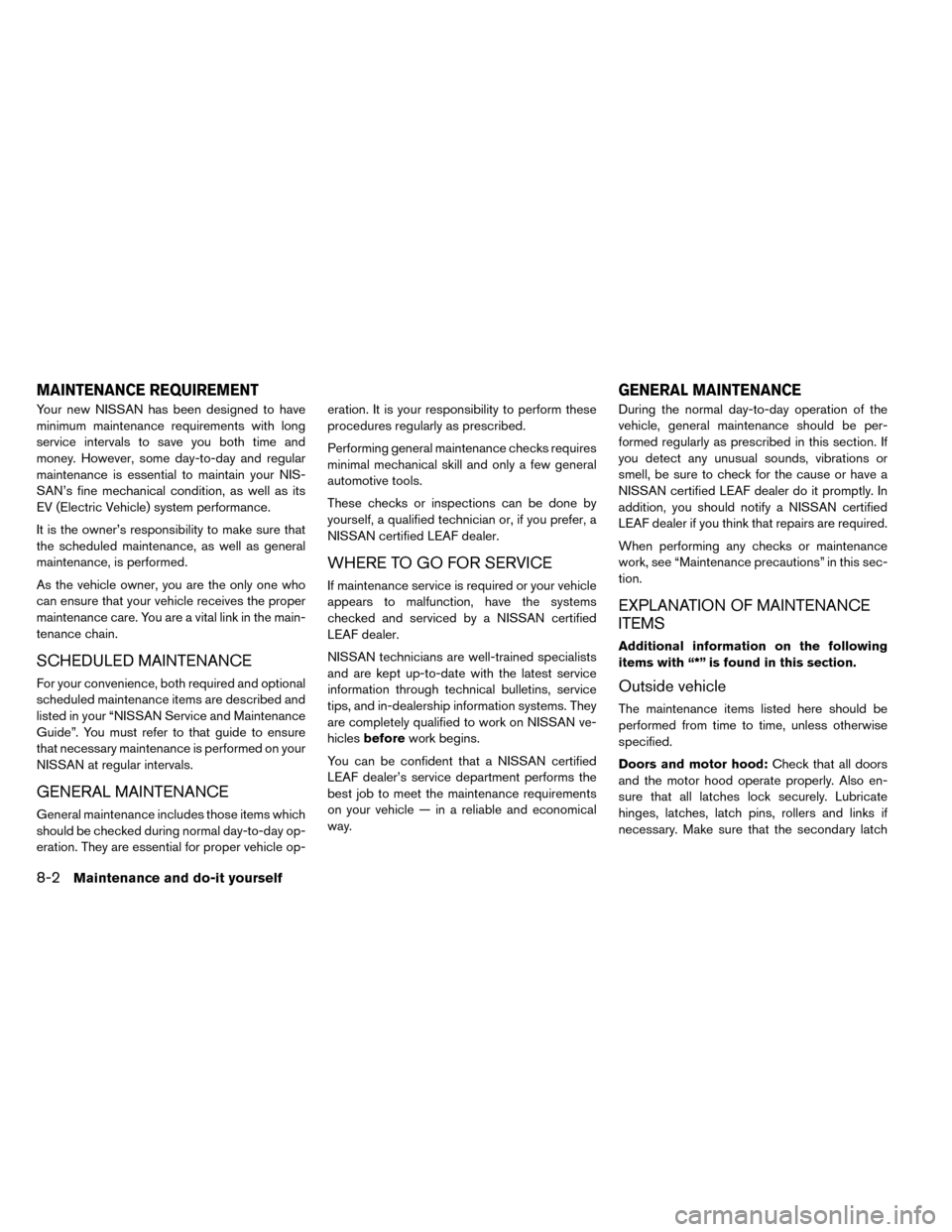
Your new NISSAN has been designed to have
minimum maintenance requirements with long
service intervals to save you both time and
money. However, some day-to-day and regular
maintenance is essential to maintain your NIS-
SAN’s fine mechanical condition, as well as its
EV (Electric Vehicle) system performance.
It is the owner’s responsibility to make sure that
the scheduled maintenance, as well as general
maintenance, is performed.
As the vehicle owner, you are the only one who
can ensure that your vehicle receives the proper
maintenance care. You are a vital link in the main-
tenance chain.
SCHEDULED MAINTENANCE
For your convenience, both required and optional
scheduled maintenance items are described and
listed in your “NISSAN Service and Maintenance
Guide”. You must refer to that guide to ensure
that necessary maintenance is performed on your
NISSAN at regular intervals.
GENERAL MAINTENANCE
General maintenance includes those items which
should be checked during normal day-to-day op-
eration. They are essential for proper vehicle op-eration. It is your responsibility to perform these
procedures regularly as prescribed.
Performing general maintenance checks requires
minimal mechanical skill and only a few general
automotive tools.
These checks or inspections can be done by
yourself, a qualified technician or, if you prefer, a
NISSAN certified LEAF dealer.
WHERE TO GO FOR SERVICE
If maintenance service is required or your vehicle
appears to malfunction, have the systems
checked and serviced by a NISSAN certified
LEAF dealer.
NISSAN technicians are well-trained specialists
and are kept up-to-date with the latest service
information through technical bulletins, service
tips, and in-dealership information systems. They
are completely qualified to work on NISSAN ve-
hicles
before work begins.
You can be confident that a NISSAN certified
LEAF dealer’s service department performs the
best job to meet the maintenance requirements
on your vehicle — in a reliable and economical
way. During the normal day-to-day operation of the
vehicle, general maintenance should be per-
formed regularly as prescribed in this section. If
you detect any unusual sounds, vibrations or
smell, be sure to check for the cause or have a
NISSAN certified LEAF dealer do it promptly. In
addition, you should notify a NISSAN certified
LEAF dealer if you think that repairs are required.
When performing any checks or maintenance
work, see “Maintenance precautions” in this sec-
tion.
EXPLANATION OF MAINTENANCE
ITEMS
Additional information on the following
items with “*” is found in this section.
Outside vehicle
The maintenance items listed here should be
performed from time to time, unless otherwise
specified.
Doors and motor hood:
Check that all doors
and the motor hood operate properly. Also en-
sure that all latches lock securely. Lubricate
hinges, latches, latch pins, rollers and links if
necessary. Make sure that the secondary latch
MAINTENANCE REQUIREMENT GENERAL MAINTENANCE
8-2Maintenance and do-it yourself
Page 342 of 412
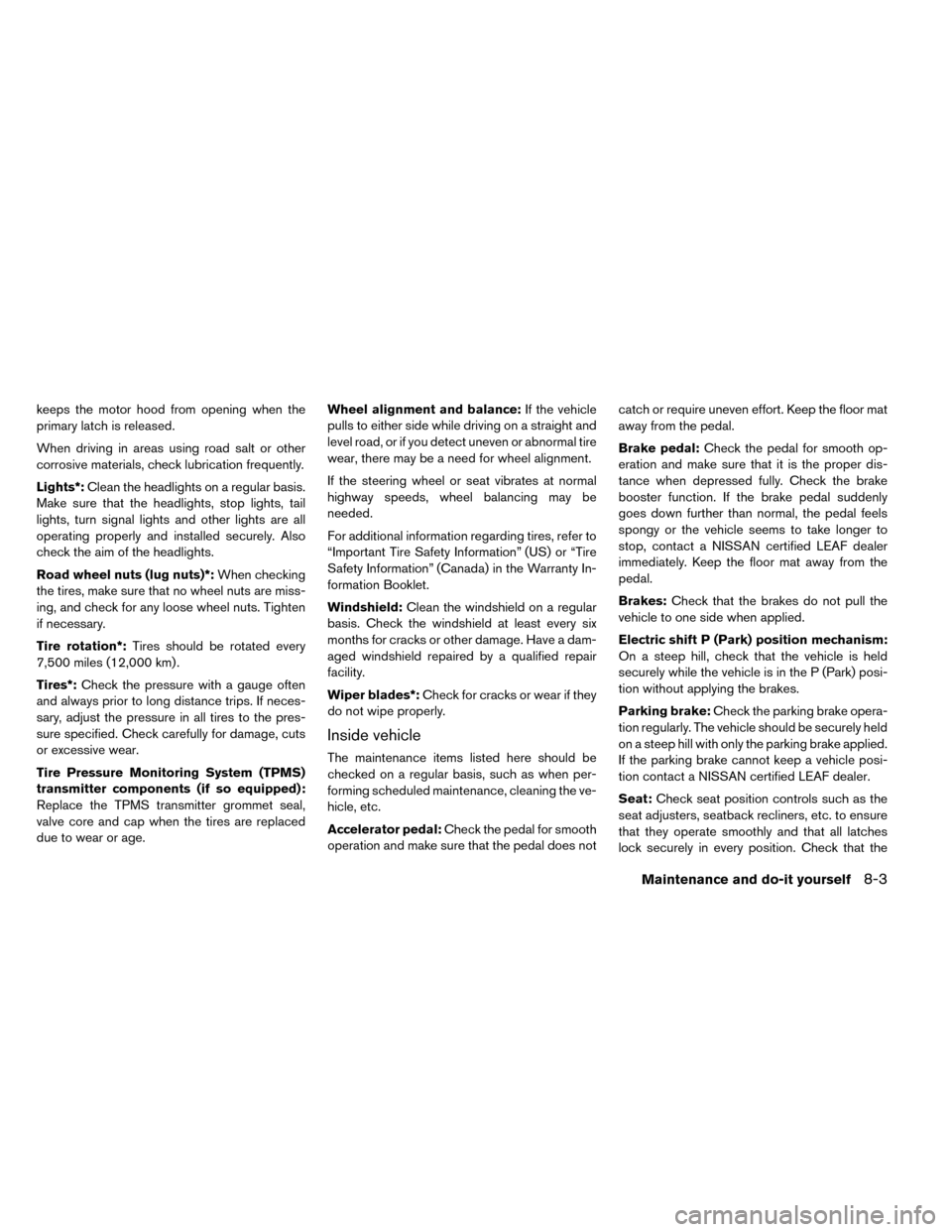
keeps the motor hood from opening when the
primary latch is released.
When driving in areas using road salt or other
corrosive materials, check lubrication frequently.
Lights*:Clean the headlights on a regular basis.
Make sure that the headlights, stop lights, tail
lights, turn signal lights and other lights are all
operating properly and installed securely. Also
check the aim of the headlights.
Road wheel nuts (lug nuts)*: When checking
the tires, make sure that no wheel nuts are miss-
ing, and check for any loose wheel nuts. Tighten
if necessary.
Tire rotation*: Tires should be rotated every
7,500 miles (12,000 km) .
Tires*: Check the pressure with a gauge often
and always prior to long distance trips. If neces-
sary, adjust the pressure in all tires to the pres-
sure specified. Check carefully for damage, cuts
or excessive wear.
Tire Pressure Monitoring System (TPMS)
transmitter components (if so equipped):
Replace the TPMS transmitter grommet seal,
valve core and cap when the tires are replaced
due to wear or age. Wheel alignment and balance:
If the vehicle
pulls to either side while driving on a straight and
level road, or if you detect uneven or abnormal tire
wear, there may be a need for wheel alignment.
If the steering wheel or seat vibrates at normal
highway speeds, wheel balancing may be
needed.
For additional information regarding tires, refer to
“Important Tire Safety Information” (US) or “Tire
Safety Information” (Canada) in the Warranty In-
formation Booklet.
Windshield: Clean the windshield on a regular
basis. Check the windshield at least every six
months for cracks or other damage. Have a dam-
aged windshield repaired by a qualified repair
facility.
Wiper blades*: Check for cracks or wear if they
do not wipe properly.
Inside vehicle
The maintenance items listed here should be
checked on a regular basis, such as when per-
forming scheduled maintenance, cleaning the ve-
hicle, etc.
Accelerator pedal: Check the pedal for smooth
operation and make sure that the pedal does not catch or require uneven effort. Keep the floor mat
away from the pedal.
Brake pedal:
Check the pedal for smooth op-
eration and make sure that it is the proper dis-
tance when depressed fully. Check the brake
booster function. If the brake pedal suddenly
goes down further than normal, the pedal feels
spongy or the vehicle seems to take longer to
stop, contact a NISSAN certified LEAF dealer
immediately. Keep the floor mat away from the
pedal.
Brakes: Check that the brakes do not pull the
vehicle to one side when applied.
Electric shift P (Park) position mechanism:
On a steep hill, check that the vehicle is held
securely while the vehicle is in the P (Park) posi-
tion without applying the brakes.
Parking brake: Check the parking brake opera-
tion regularly. The vehicle should be securely held
on a steep hill with only the parking brake applied.
If the parking brake cannot keep a vehicle posi-
tion contact a NISSAN certified LEAF dealer.
Seat: Check seat position controls such as the
seat adjusters, seatback recliners, etc. to ensure
that they operate smoothly and that all latches
lock securely in every position. Check that the
Maintenance and do-it yourself8-3
Page 343 of 412
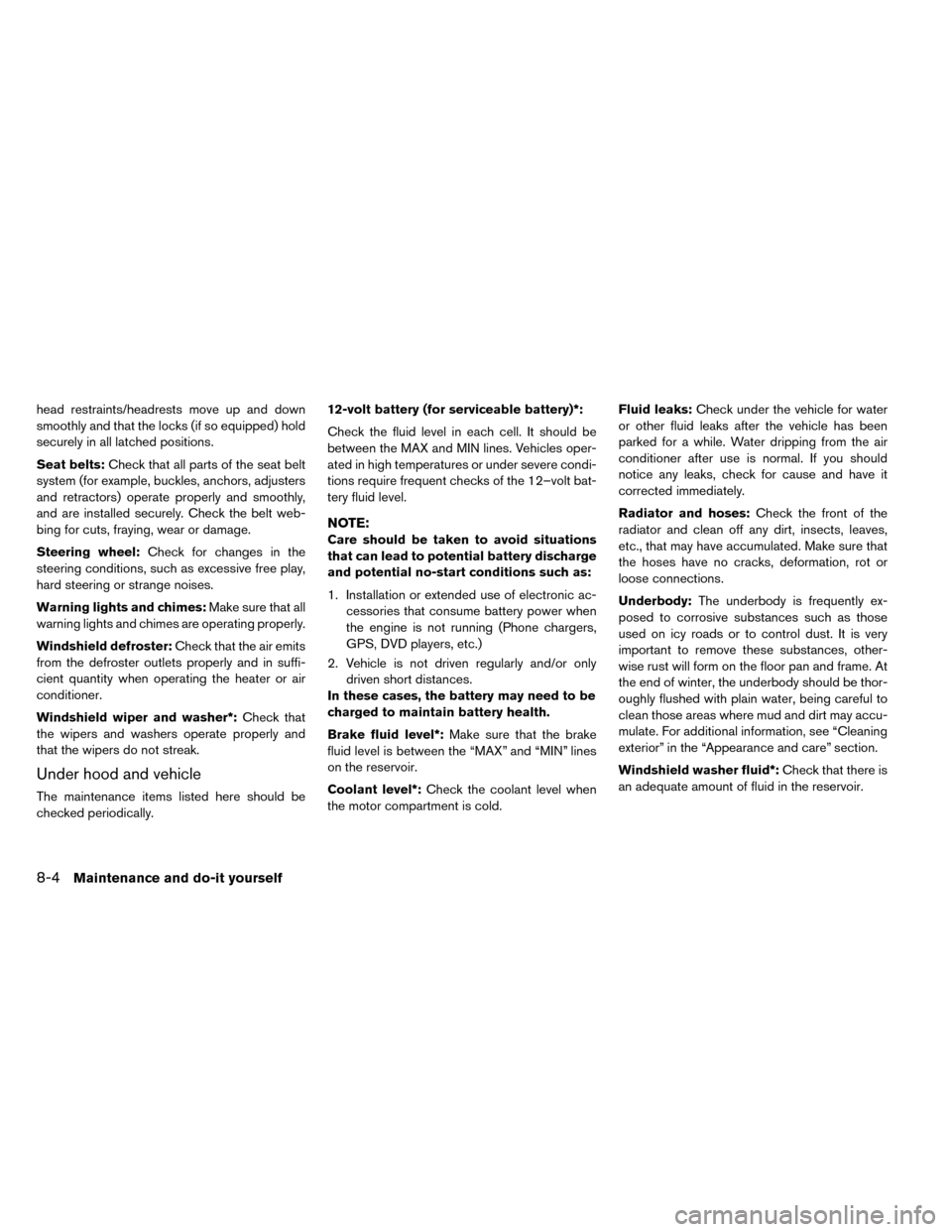
head restraints/headrests move up and down
smoothly and that the locks (if so equipped) hold
securely in all latched positions.
Seat belts:Check that all parts of the seat belt
system (for example, buckles, anchors, adjusters
and retractors) operate properly and smoothly,
and are installed securely. Check the belt web-
bing for cuts, fraying, wear or damage.
Steering wheel: Check for changes in the
steering conditions, such as excessive free play,
hard steering or strange noises.
Warning lights and chimes: Make sure that all
warning lights and chimes are operating properly.
Windshield defroster: Check that the air emits
from the defroster outlets properly and in suffi-
cient quantity when operating the heater or air
conditioner.
Windshield wiper and washer*: Check that
the wipers and washers operate properly and
that the wipers do not streak.
Under hood and vehicle
The maintenance items listed here should be
checked periodically. 12-volt battery (for serviceable battery)*:
Check the fluid level in each cell. It should be
between the MAX and MIN lines. Vehicles oper-
ated in high temperatures or under severe condi-
tions require frequent checks of the 12–volt bat-
tery fluid level.
NOTE:
Care should be taken to avoid situations
that can lead to potential battery discharge
and potential no-start conditions such as:
1. Installation or extended use of electronic ac-
cessories that consume battery power when
the engine is not running (Phone chargers,
GPS, DVD players, etc.)
2. Vehicle is not driven regularly and/or only driven short distances.
In these cases, the battery may need to be
charged to maintain battery health.
Brake fluid level*: Make sure that the brake
fluid level is between the “MAX” and “MIN” lines
on the reservoir.
Coolant level*: Check the coolant level when
the motor compartment is cold. Fluid leaks:
Check under the vehicle for water
or other fluid leaks after the vehicle has been
parked for a while. Water dripping from the air
conditioner after use is normal. If you should
notice any leaks, check for cause and have it
corrected immediately.
Radiator and hoses: Check the front of the
radiator and clean off any dirt, insects, leaves,
etc., that may have accumulated. Make sure that
the hoses have no cracks, deformation, rot or
loose connections.
Underbody: The underbody is frequently ex-
posed to corrosive substances such as those
used on icy roads or to control dust. It is very
important to remove these substances, other-
wise rust will form on the floor pan and frame. At
the end of winter, the underbody should be thor-
oughly flushed with plain water, being careful to
clean those areas where mud and dirt may accu-
mulate. For additional information, see “Cleaning
exterior” in the “Appearance and care” section.
Windshield washer fluid*: Check that there is
an adequate amount of fluid in the reservoir.
8-4Maintenance and do-it yourself
Page 344 of 412
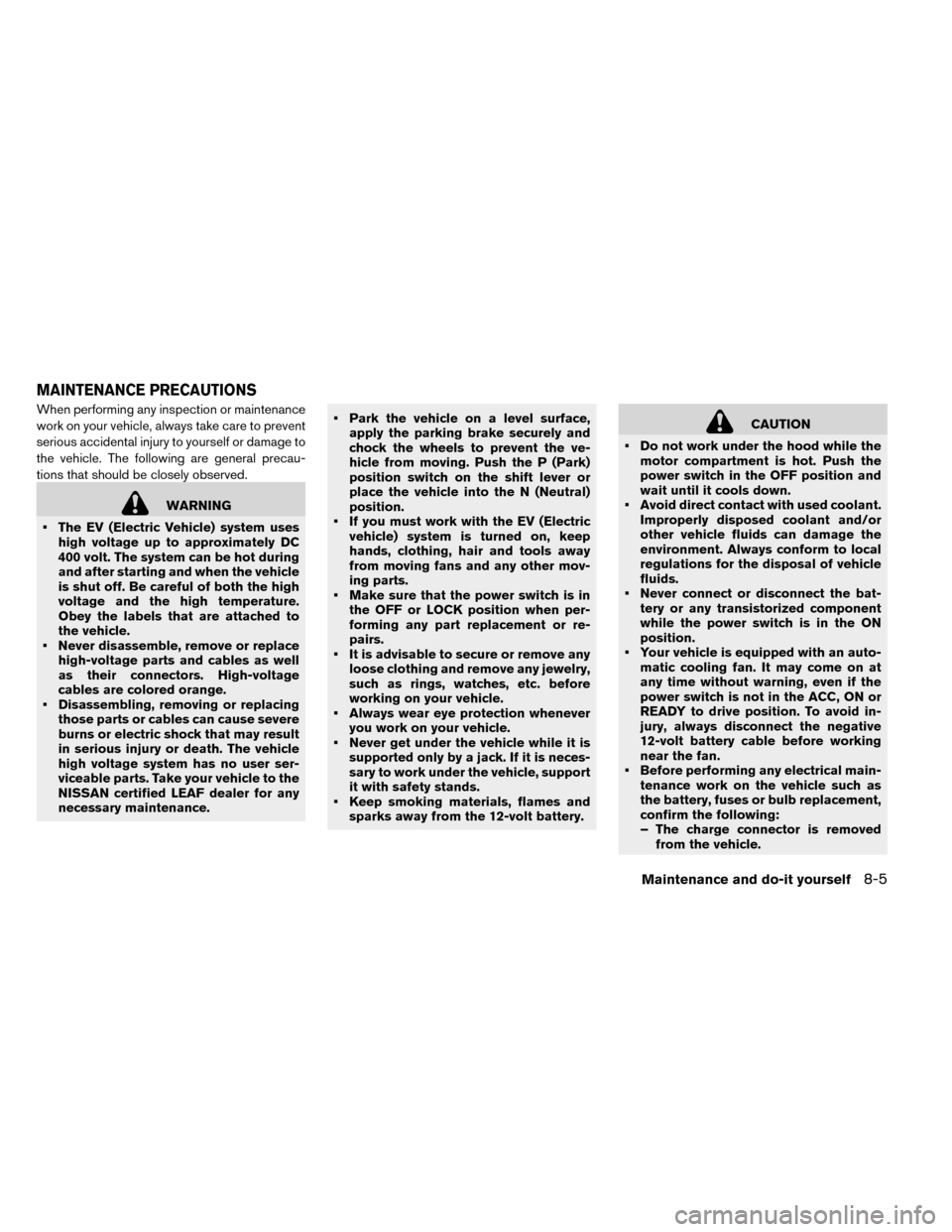
When performing any inspection or maintenance
work on your vehicle, always take care to prevent
serious accidental injury to yourself or damage to
the vehicle. The following are general precau-
tions that should be closely observed.
WARNING
• The EV (Electric Vehicle) system uses high voltage up to approximately DC
400 volt. The system can be hot during
and after starting and when the vehicle
is shut off. Be careful of both the high
voltage and the high temperature.
Obey the labels that are attached to
the vehicle.
• Never disassemble, remove or replace high-voltage parts and cables as well
as their connectors. High-voltage
cables are colored orange.
• Disassembling, removing or replacing those parts or cables can cause severe
burns or electric shock that may result
in serious injury or death. The vehicle
high voltage system has no user ser-
viceable parts. Take your vehicle to the
NISSAN certified LEAF dealer for any
necessary maintenance. • Park the vehicle on a level surface,
apply the parking brake securely and
chock the wheels to prevent the ve-
hicle from moving. Push the P (Park)
position switch on the shift lever or
place the vehicle into the N (Neutral)
position.
• If you must work with the EV (Electric vehicle) system is turned on, keep
hands, clothing, hair and tools away
from moving fans and any other mov-
ing parts.
• Make sure that the power switch is in the OFF or LOCK position when per-
forming any part replacement or re-
pairs.
• It is advisable to secure or remove any loose clothing and remove any jewelry,
such as rings, watches, etc. before
working on your vehicle.
• Always wear eye protection whenever you work on your vehicle.
• Never get under the vehicle while it is supported only by a jack. If it is neces-
sary to work under the vehicle, support
it with safety stands.
• Keep smoking materials, flames and sparks away from the 12-volt battery.
CAUTION
• Do not work under the hood while the motor compartment is hot. Push the
power switch in the OFF position and
wait until it cools down.
• Avoid direct contact with used coolant. Improperly disposed coolant and/or
other vehicle fluids can damage the
environment. Always conform to local
regulations for the disposal of vehicle
fluids.
• Never connect or disconnect the bat- tery or any transistorized component
while the power switch is in the ON
position.
• Your vehicle is equipped with an auto- matic cooling fan. It may come on at
any time without warning, even if the
power switch is not in the ACC, ON or
READY to drive position. To avoid in-
jury, always disconnect the negative
12-volt battery cable before working
near the fan.
• Before performing any electrical main- tenance work on the vehicle such as
the battery, fuses or bulb replacement,
confirm the following:
– The charge connector is removedfrom the vehicle.
MAINTENANCE PRECAUTIONS
Maintenance and do-it yourself8-5
Page 398 of 412
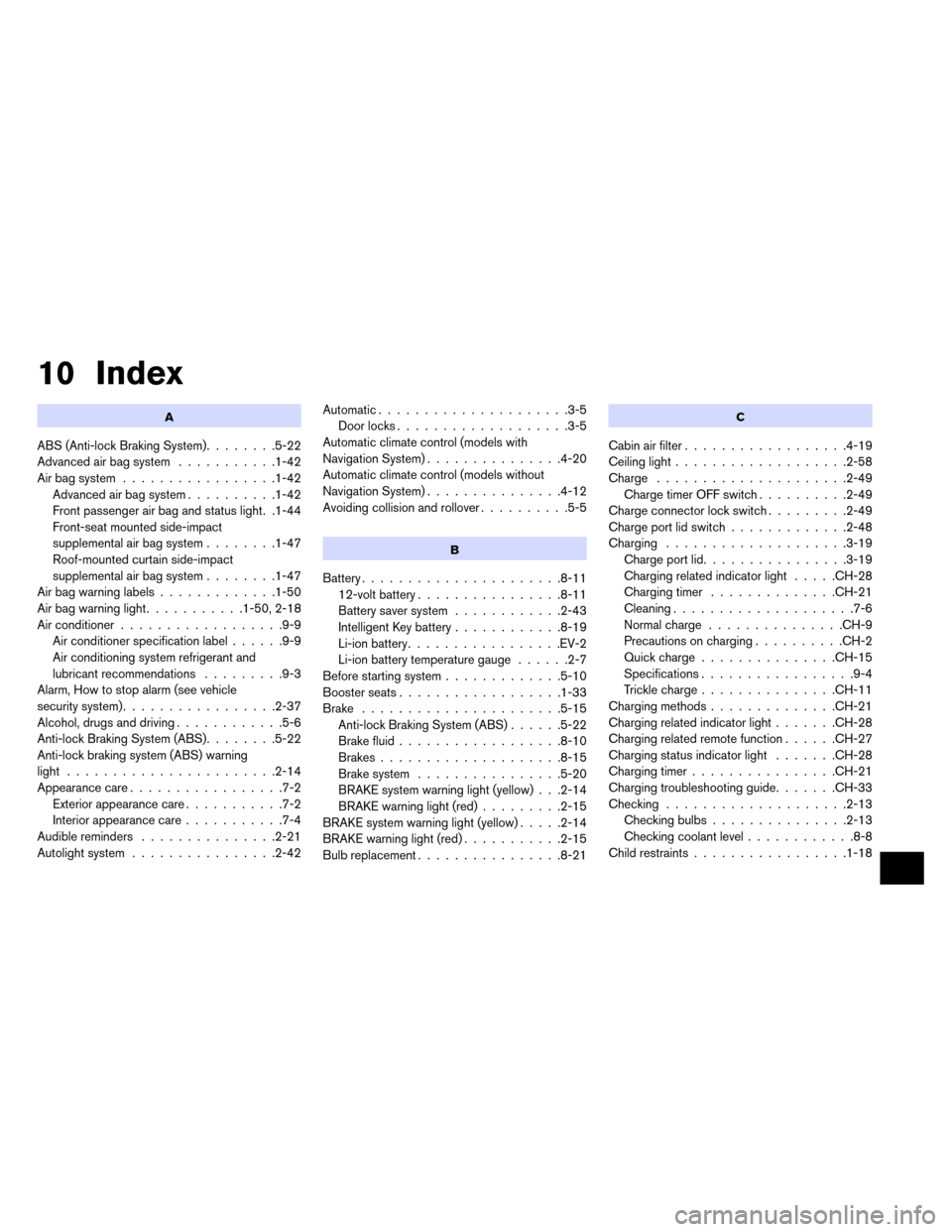
10 Index
A
ABS (Anti-lock Braking System)........5-22
Advanced air bag system ...........1-42
Air bag system .................1-42
Advanced air bag system ..........1-42
Front passenger air bag and status light. .1-44
Front-seat mounted side-impact
supplemental air bag system ........1-47
Roof-mounted curtain side-impact
supplemental air bag system ........1-47
Airbagwarninglabels.............1-50
Airbagwarninglight...........1-50,2-18
Air conditioner ..................9-9
Air conditioner specification label ......9-9
Air conditioning system refrigerant and
lubricant recommendations .........9-3
Alarm, How to stop alarm (see vehicle
security system) .................2-37
Alcohol, drugs and driving ............5-6
Anti-lock Braking System (ABS) ........5-22
Anti-lock braking system (ABS) warning
light .......................2-14
Appearance care .................7-2
Exterior appearance care ...........7-2
Interior appearance care ...........7-4
Audible reminders ...............2-21
Autolight system ................2-42 Automatic.....................3-5
Door locks ...................3-5
Automatic climate control (models with
Navigation System) ...............4-20
Automatic climate control (models without
Navigation System) ...............4-12
Avoiding collision and rollover ..........5-5
B
Battery......................8-11
12-volt battery ................8-11
Battery saver system ............2-43
Intelligent Key battery ............8-19
Li-ion battery .................EV-2
Li-ion battery temperature gauge ......2-7
Before starting system .............5-10
Boosterseats..................1-33
Brake ......................5-15 Anti-lock Braking System (ABS) ......5-22
Brakefluid..................8-10
Brakes....................8-15
Brake system ................5-20
BRAKE system warning light (yellow) . . .2-14
BRAKE warning light (red) .........2-15
BRAKE system warning light (yellow) .....2-14
BRAKE warning light (red) ...........2-15
Bulb replacement ................8-21
C
Cabin air filter..................4-19
Ceiling light ...................2-58
Charge .....................2-49
Charge timer OFF switch ..........2-49
Charge connector lock switch .........2-49
Charge port lid switch .............2-48
Charging ....................3-19
Chargeportlid................3-19
Charging related indicator light .....CH-28
Chargingtimer ..............CH-21
Cleaning ....................7-6
Normalcharge ...............CH-9
Precautions on charging ..........CH-2
Quickcharge...............CH-15
Specifications .................9-4
Trickle charge ...............CH-11
Charging methods ..............CH-21
Charging related indicator light .......CH-28
Charging related remote function ......CH-27
Charging status indicator light .......CH-28
Charging timer ................CH-21
Charging troubleshooting guide .......CH-33
Checking ....................2-13
Checkingbulbs...............2-13
Checking coolant level ............8-8
Child restraints .................1-18
Page 399 of 412
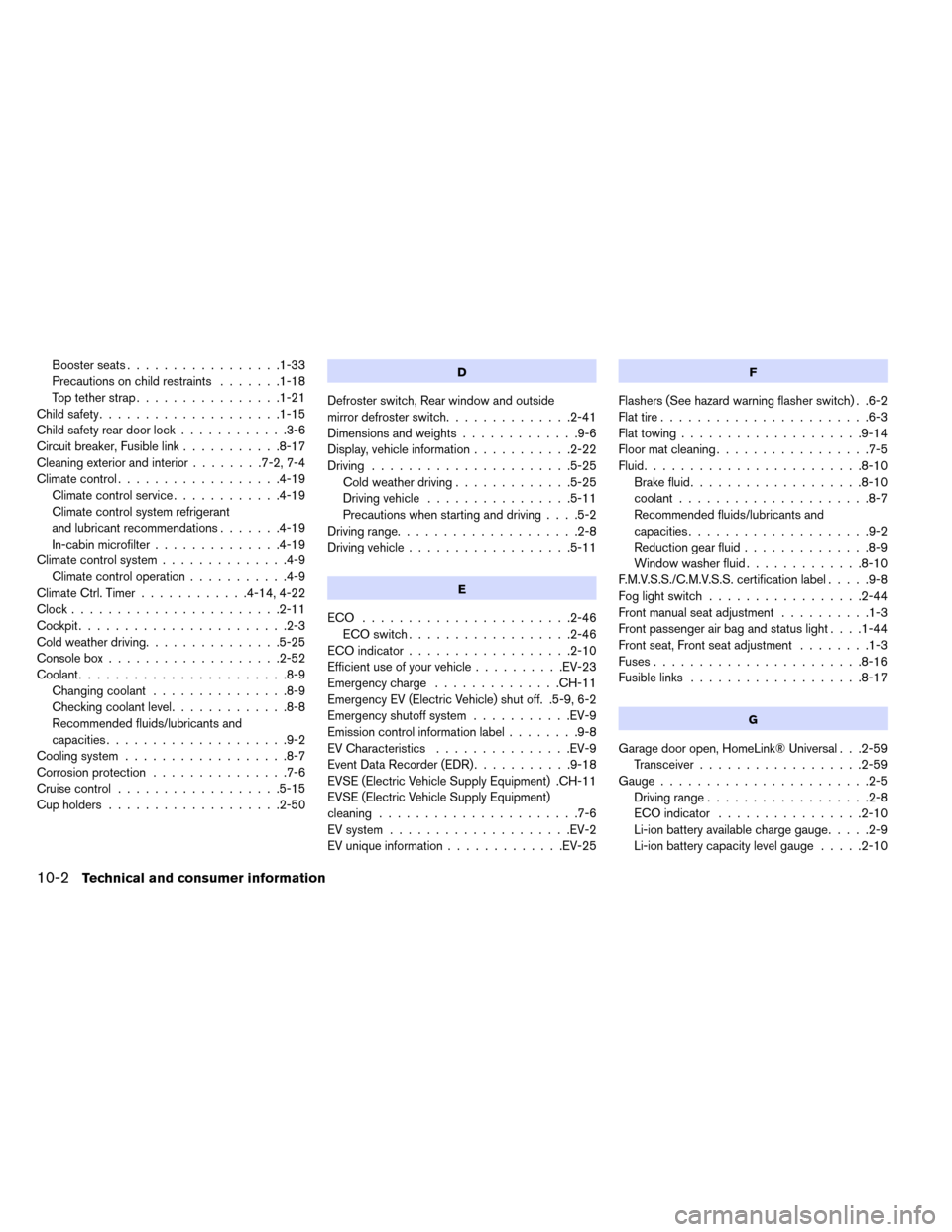
Boosterseats.................1-33
Precautions on child restraints.......1-18
Top tether strap ................1-21
Childsafety....................1-15
Child safety rear door lock ............3-6
Circuit breaker, Fusible link ...........8-17
Cleaning exterior and interior ........7-2,7-4
Climatecontrol..................4-19 Climate control service ............4-19
Climate control system refrigerant
and lubricant recommendations .......4-19
In-cabin microfilter ..............4-19
Climate control system ..............4-9
Climate control operation ...........4-9
Climate Ctrl. Timer ............4-14,4-22
Clock.......................2-11
Cockpit.......................2-3
Cold weather driving ...............5-25
Consolebox...................2-52
Coolant.......................8-9 Changingcoolant ...............8-9
Checkingcoolantlevel.............8-8
Recommended fluids/lubricants and
capacities ....................9-2
Cooling system ..................8-7
Corrosionprotection ...............7-6
Cruisecontrol..................5-15
Cupholders...................2-50D
Defroster switch, Rear window and outside
mirror defroster switch ..............2-41
Dimensionsandweights.............9-6
Display, vehicle information ...........2-22
Driving ......................5-25
Cold weather driving .............5-25
Driving vehicle ................5-11
Precautions when starting and driving ....5-2
Driving range ....................2-8
Driving vehicle ..................5-11
E
ECO .......................2-46
ECO switch ..................2-46
ECOindicator..................2-10
Efficient use of your vehicle ..........EV-23
Emergency charge ..............CH-11
Emergency EV (Electric Vehicle) shut off. .5-9, 6-2
Emergency shutoff system ...........EV-9
Emission control information label ........9-8
EV Characteristics ...............EV-9
Event Data Recorder (EDR) ...........9-18
EVSE (Electric Vehicle Supply Equipment) .CH-11
EVSE (Electric Vehicle Supply Equipment)
cleaning ......................7-6
EV system ....................EV-2
EV unique information .............EV-25
F
Flashers (See hazard warning flasher switch) . .6-2
Flat tire.......................6-3
Flattowing....................9-14
Floormatcleaning.................7-5
Fluid ........................8-10
Brake fluid ...................8-10
coolant.....................8-7
Recommended fluids/lubricants and
capacities ....................9-2
Reduction gear fluid ..............8-9
Window washer fluid .............8-10
F.M.V.S.S./C.M.V.S.S. certification label .....9-8
Foglightswitch .................2-44
Frontmanualseatadjustment ..........1-3
Front passenger air bag and status light ....1-44
Front seat, Front seat adjustment ........1-3
Fuses.......................8-16
Fusiblelinks ...................8-17
G
Garage door open, HomeLink® Universal . . .2-59 Transceiver ..................2-59
Gauge.......................2-5 Driving range ..................2-8
ECO indicator ................2-10
Li-ion battery available charge gauge .....2-9
Li-ion battery capacity level gauge .....2-10
10-2Technical and consumer information
Page 401 of 412
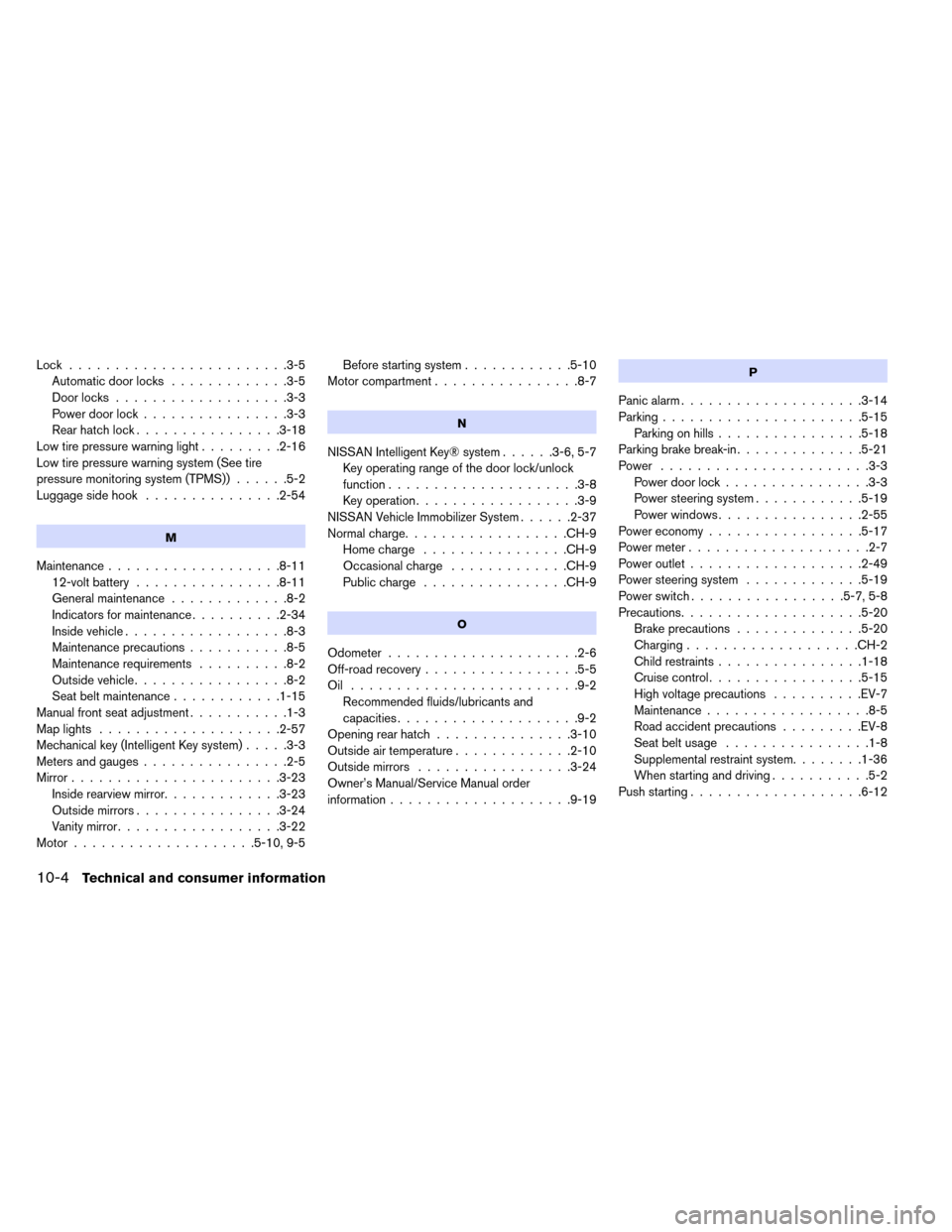
Lock........................3-5
Automatic door locks .............3-5
Door locks ...................3-3
Power door lock ................3-3
Rearhatchlock................3-18
Low tire pressure warning light .........2-16
Low tire pressure warning system (See tire
pressure monitoring system (TPMS)) ......5-2
Luggage side hook ...............2-54
M
Maintenance...................8-11
12-volt battery ................8-11
Generalmaintenance .............8-2
Indicatorsformaintenance..........2-34
Inside vehicle ..................8-3
Maintenance precautions ...........8-5
Maintenance requirements ..........8-2
Outside vehicle .................8-2
Seatbeltmaintenance............1-15
Manual front seat adjustment ...........1-3
Maplights ....................2-57
Mechanical key (Intelligent Key system) .....3-3
Meters and gauges ................2-5
Mirror .......................3-23
Inside rearview mirror.............3-23
Outside mirrors ................3-24
Vanity mirror ..................3-22
Motor....................5-10,9-5 Before starting system
............5-10
Motor compartment ................8-7
N
NISSAN Intelligent Key® system ......3-6,5-7
Key operating range of the door lock/unlock
function.....................3-8
Key operation ..................3-9
NISSAN Vehicle Immobilizer System ......2-37
Normalcharge..................CH-9 Home charge ................CH-9
Occasional charge .............CH-9
Publiccharge ................CH-9
O
Odometer .....................2-6
Off-road recovery .................5-5
Oil .........................9-2 Recommended fluids/lubricants and
capacities ....................9-2
Opening rear hatch ...............3-10
Outside air temperature .............2-10
Outside mirrors .................3-24
Owner’s Manual/Service Manual order
information ....................9-19
P
Panic alarm....................3-14
Parking ......................5-15
Parking on hills ................5-18
Parking brake break-in ..............5-21
Power .......................3-3 Power door lock ................3-3
Power steering system ............5-19
Power windows ................2-55
Powereconomy.................5-17
Powermeter....................2-7
Power outlet ...................2-49
Power steering system .............5-19
Powerswitch.................5-7,5-8
Precautions ....................5-20
Brake precautions ..............5-20
Charging ...................CH-2
Child restraints ................1-18
Cruise control .................5-15
High voltage precautions ..........EV-7
Maintenance..................8-5
Road accident precautions .........EV-8
Seatbeltusage ................1-8
Supplemental restraint system........1-36
When starting and driving ...........5-2
Push starting ...................6-12
10-4Technical and consumer information
Page 402 of 412
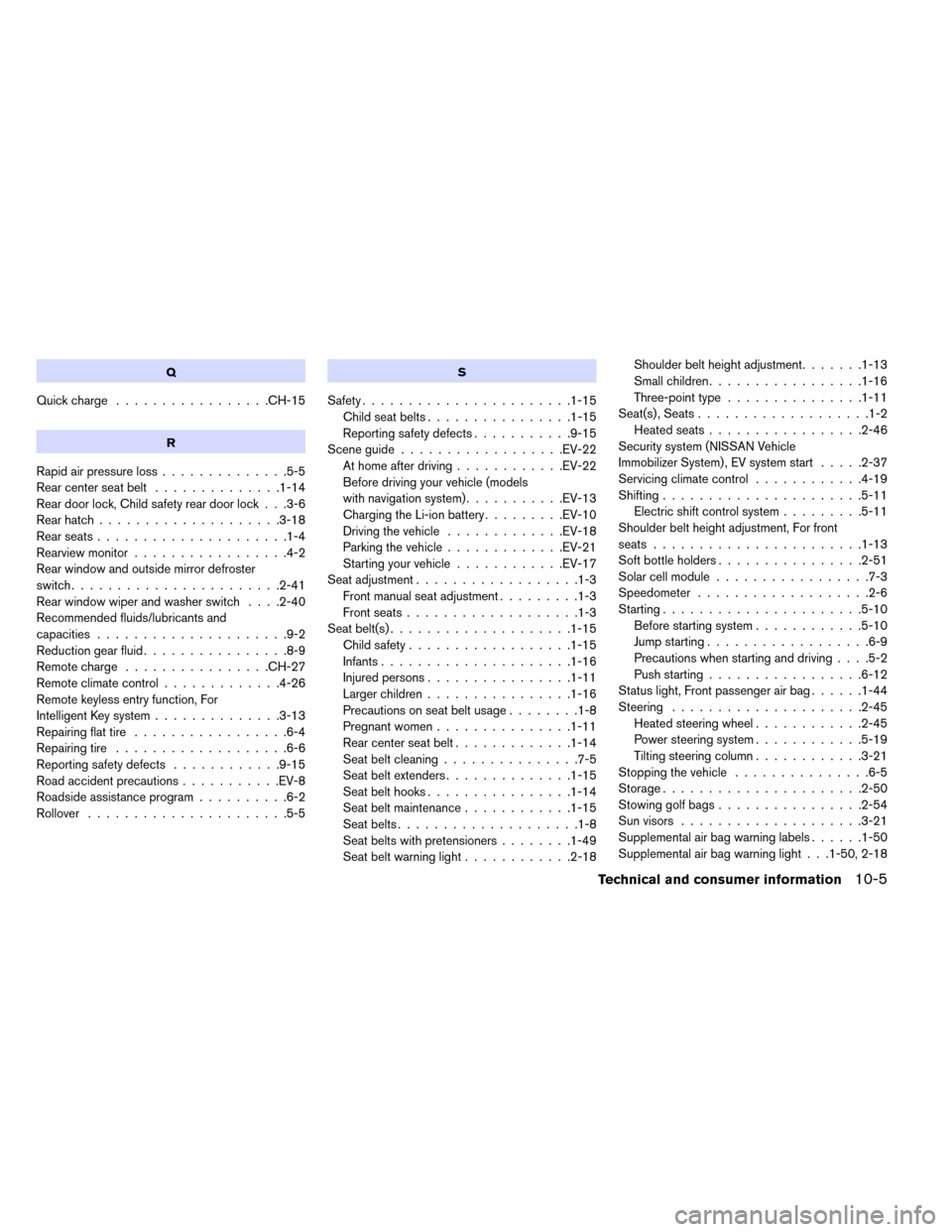
Q
Quickcharge .................CH-15
R
Rapidairpressureloss..............5-5
Rearcenterseatbelt ..............1-14
Rear door lock, Child safety rear door lock . . .3-6
Rear hatch....................3-18
Rearseats.....................1-4
Rearview monitor .................4-2
Rear window and outside mirror defroster
switch .......................2-41
Rear window wiper and washer switch ....2-40
Recommended fluids/lubricants and
capacities .....................9-2
Reductiongearfluid................8-9
Remotecharge ................CH-27
Remoteclimatecontrol.............4-26
Remote keyless entry function, For
Intelligent Key system ..............3-13
Repairing flat tire .................6-4
Repairing tire ...................6-6
Reporting safety defects ............9-15
Road accident precautions ...........EV-8
Roadside assistance program ..........6-2
Rollover ......................5-5
S
Safety.......................1-15 Childseatbelts................1-15
Reporting safety defects ...........9-15
Sceneguide..................EV-22 At home after driving ............EV-22
Before driving your vehicle (models
with navigation system) ...........EV-13
Charging the Li-ion battery .........EV-10
Driving the vehicle .............EV-18
Parking the vehicle .............EV-21
Starting your vehicle ............EV-17
Seat adjustment ..................1-3
Front manual seat adjustment .........1-3
Frontseats...................1-3
Seat belt(s) ....................1-15
Child safety ..................1-15
Infants.....................1-16
Injuredpersons................1-11
Largerchildren................1-16
Precautions on seat belt usage ........1-8
Pregnant women ...............1-11
Rear center seat belt .............1-14
Seatbeltcleaning...............7-5
Seatbeltextenders..............1-15
Seat belt hooks ................1-14
Seat belt maintenance ............1-15
Seatbelts....................1-8
Seat belts with pretensioners ........1-49
Seatbeltwarninglight............2-18 Shoulder belt height adjustment
.......1-13
Small children .................1-16
Three-pointtype...............1-11
Seat(s) , Seats ...................1-2
Heatedseats.................2-46
Security system (NISSAN Vehicle
Immobilizer System) , EV system start .....2-37
Servicing climate control ............4-19
Shifting ......................5-11
Electric shift control system .........5-11
Shoulder belt height adjustment, For front
seats .......................1-13
Soft bottle holders ................2-51
Solar cell module .................7-3
Speedometer ...................2-6
Starting ......................5-10
Before starting system ............5-10
Jump starting ..................6-9
Precautions when starting and driving ....5-2
Push starting .................6-12
Status light, Front passenger air bag ......1-44
Steering .....................2-45 Heated steering wheel ............2-45
Power steering system ............5-19
Tilting steering column ............3-21
Stopping the vehicle ...............6-5
Storage......................2-50
Stowing golf bags ................2-54
Sun visors ....................3-21
Supplemental air bag warning labels ......1-50
Supplemental air bag warning light . . .1-50, 2-18
Technical and consumer information10-5